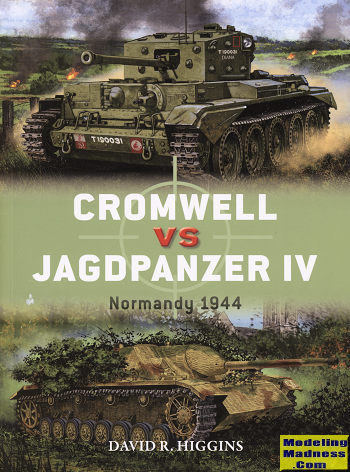 This
latest matchup in Osprey's popular Duel series concentrates on two adversaries
that entered service pretty much around the same time. This time, the meeting
place is Normandy where the Cromwell was first used in numbers. While much of
what is written about D-day focuses on the US and Omaha beach, where the German
resistance was the greatest, few know that most of the armor battles were with
the British part of the invasion front. It is true that the Commonwealth forces
actually got ashore with much fewer casualties, but it does not mean they had it
easy.
This
latest matchup in Osprey's popular Duel series concentrates on two adversaries
that entered service pretty much around the same time. This time, the meeting
place is Normandy where the Cromwell was first used in numbers. While much of
what is written about D-day focuses on the US and Omaha beach, where the German
resistance was the greatest, few know that most of the armor battles were with
the British part of the invasion front. It is true that the Commonwealth forces
actually got ashore with much fewer casualties, but it does not mean they had it
easy.
Normandy is where the British first ran across the
Jagdpaner IV. The assault gun was one that was used by all sides save the
Americans, but it was the German army that put it to its best use and developed
tactics regarding its use. This weapon had the plus of being inexpensive to
build, when compared to the standard tank as it used the same chassis. It also
was able to house a fairly good size weapon that was capable of taking out just
about all British and American tanks from a fairly good distance. Its low
silhouette also made it a lot easier to hide in ambushy to camouflage. Indeed
these were very much mobile anti-tank guns. The standard towed guns were still
very useful and greatly used, but the jagdpanzer was able to move away fast
enough to keep from being pinpointed and destroyed. Its greater armor also
stopped all but the closest enemy tank fire. It did have its down sides and that
was the inability to traverse the gun more than a few degrees and the thin upper
surface armor was fine against small arms, but was fairly easily penetrated by
fighter bombers and their rocket projectiles.
The Cromwell was, at the time, the pinnacle of British
armor, which meant that it was a bit lacking compared to American and German
armor. It had its issues with the lack of a really powerful gun and somewhat
thin armor. Indeed, many Commonwealth tank crews who transitioned from the
Sherman would have preferred the Sherman. However, the Cromwell was nearly as
good and unlike earlier British tanks, was pretty reliable with good speed and a
gun that was useful at short ranges. Another down side was the lack of HE
ammunition for its gun. This is something that plagued most British tanks until
the Centurion came into service. Interestingly, it was also the first widely
produced British tank that was not riveted, but welded. If properly handled, it
was quite effective and it was built in fairly large numbers where it opponent
was spread thin.
In this book the author covers the development of both
the Cromwell and the Jagdpanzer IV. Then it covers the technical specifications
of the two subjects as well as how the crews trained to use these AFVs. It then
discusses the tactical situation at the time they were put into combat with each
other and finally, a goodly portion of the book looks at how they fared in
combat against each other. It is a
superb book on the subject and one that I am positive you will enjoy reading.
Highly recommended.
June 2018
Copyright ModelingMadness.com
For more on the complete line of Osprey books,
visit www.ospreypublishing.com .
If you would like your product reviewed fairly and quickly, please
contact
me or see other details in the
Note to
Contributors.
 This
latest matchup in Osprey's popular Duel series concentrates on two adversaries
that entered service pretty much around the same time. This time, the meeting
place is Normandy where the Cromwell was first used in numbers. While much of
what is written about D-day focuses on the US and Omaha beach, where the German
resistance was the greatest, few know that most of the armor battles were with
the British part of the invasion front. It is true that the Commonwealth forces
actually got ashore with much fewer casualties, but it does not mean they had it
easy.
This
latest matchup in Osprey's popular Duel series concentrates on two adversaries
that entered service pretty much around the same time. This time, the meeting
place is Normandy where the Cromwell was first used in numbers. While much of
what is written about D-day focuses on the US and Omaha beach, where the German
resistance was the greatest, few know that most of the armor battles were with
the British part of the invasion front. It is true that the Commonwealth forces
actually got ashore with much fewer casualties, but it does not mean they had it
easy.